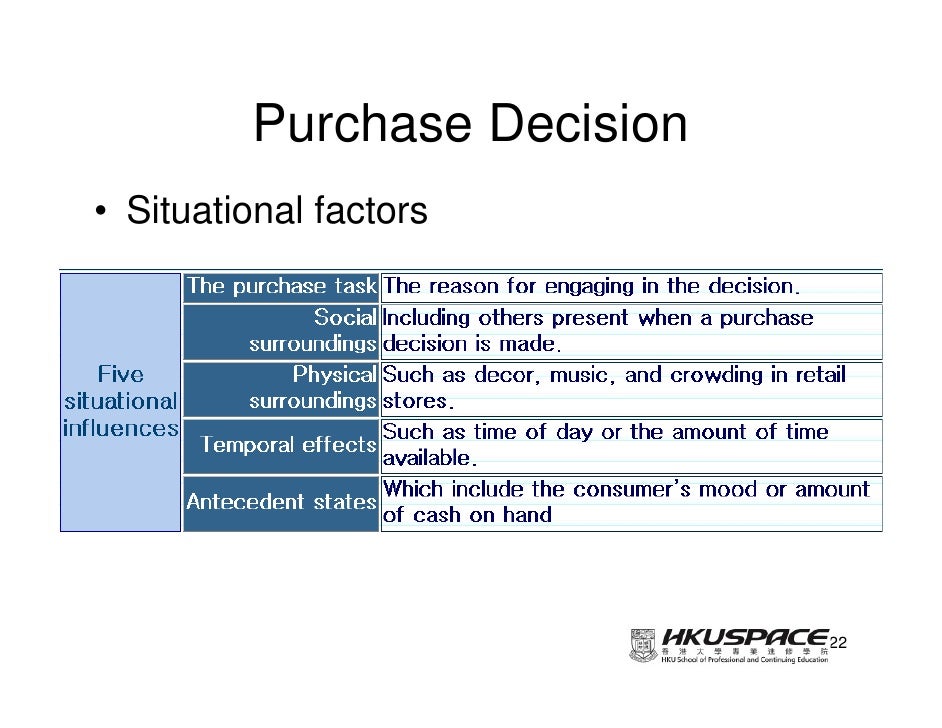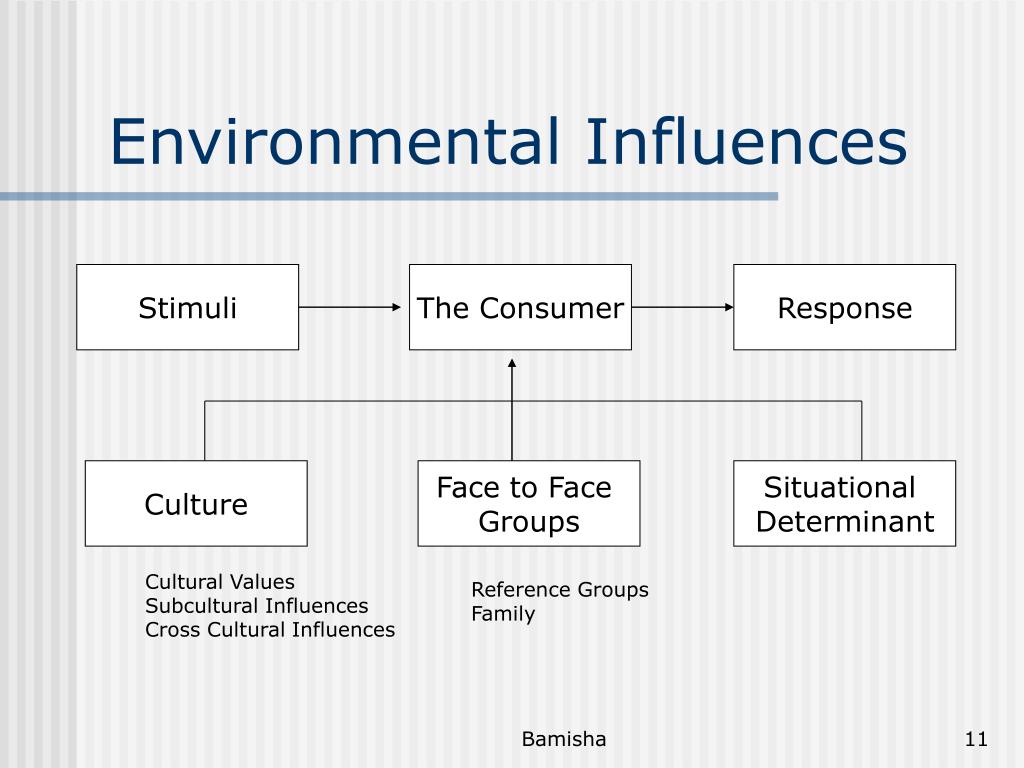
We describe a model of attitude–behavior relations, the behavioral perspective model (BPM), which suggests how situational influences on consumer choice may be categorized, and employ Mehrabian and Russell's [An approach to environmental blogger.com by: Situational influences are temporary conditions that affect how buyers behave. They include physical factors such as a store’s buying locations, layout, music, lighting, and even scent. Companies try to make the physical factors in which consumers shop as favorable as possible. If they can’t, they utilize other tactics such as discounts Jul 21, · Situational Influences Affecting Consumer Purchasing Decision Specific Situational Influences. Situational influences on consumer buying behaviour are actually impermanent conditions Physical Surroundings. This category of situational factors include marketer’s geographical and institutional
Factors That Influence Consumers’ Buying Behavior – Core Principles of Marketing
Describe the personal and psychological factors that may influence what consumers buy and when they buy it. Explain how looking at lifestyle information helps firms understand what consumers want to purchase. Other consumers follow a similar process, but different people, no matter how similar they are, make different purchasing decisions.
You might be very interested in purchasing a Smart Car, but your best friend might want to buy a Ford F truck. As we mentioned earlier in the chapter, consumer behavior is influenced by many things, including environmental and marketing factors, the situation, personal and psychological factors, family, and culture.
Businesses try to figure out trends so they can reach the people most likely to buy their products in the most cost-effective way possible. Situational influences the consumers face some influences may be temporary and others are long lasting, different factors can affect how buyers behave—whether they influence you to make a purchase, buy additional products, or buy nothing at all. Presumably, situational influences the consumers face, the longer you wander around a facility, the more you will spend.
Grocery stores frequently place bread and milk products on the opposite ends of the stores because people often need both types of products. To buy both, they have to walk around an entire store, which of course, is loaded with other items they might see and purchase.
Store locations also influence behavior. Starbucks has done a good job in terms of locating its stores. It has the process down to a science; you can scarcely drive a few miles down the road without passing a Starbucks. You can also buy cups of Starbucks coffee at many grocery stores and in airports—virtually any place where there is foot traffic. Physical factors that firms can control, situational influences the consumers face, such as the layout of a store, music played at stores, the lighting, temperature, situational influences the consumers face, and even the smells you experience are called atmospherics.
The managers of the complex were trying to get you to stay for a while and have a look at their facilities. Mirrors near hotel elevators are another example. Take weather, for example. Rainy weather can be a boon to some companies, like umbrella makers such as Totes, but a problem for others. Beach resorts, outdoor concert venues, and golf courses suffer when it is raining heavily. Businesses such as automobile dealers also have fewer customers. Who wants to shop for a car in the rain?
Firms often attempt to deal with adverse physical factors such as bad weather by offering specials during unattractive times. For example, many resorts offer consumers discounts to travel to beach locations during hurricane season. Having an online presence is another way to cope with weather-related problems. What could be more comfortable than shopping at home? You can shop online for cars, too, and many restaurants take orders online and deliver. Crowding is another situational factor.
Have you ever left a store and not purchased anything because it was just too crowded? Some studies have shown that consumers feel better about retailers who attempt to prevent overcrowding in their stores. If people are lined up to buy something, you want to situational influences the consumers face why. Should you get in line to buy it too? Herd behavior helped drive up the price of houses in the mids before the prices for them rapidly fell.
Unfortunately, herd behavior has also led to the deaths of people. Ina store employee was trampled to death by an early morning crowd rushing into a Walmart to snap up holiday bargains. Are you going to turn her down or be a friendly neighbor and buy a box or two? Are you going to turn down cookies from this cute Girl Scout? Pass the milk, please! Companies like Pampered Chef that sell their products at parties understand that the social situation makes a difference.
Certain social situations can also make you less willing to buy products. Where do you take someone for your first date? The time of day, time of year, and how much time consumers feel like they have to shop affect what they buy. Have you ever gone to the grocery store when you are hungry or after pay day when you have cash in your pocket? When you are hungry or have cash, situational influences the consumers face, you may purchase more than you would at other times. The goal is to get the products on the shelves when and where consumers want them.
Likewise, if you need customer service from Amazon. The reason you are shopping also affects the amount of time you will spend shopping. Are you making an emergency purchase? What if you need something for an important dinner or a project and only have an hour to get everything? Are you shopping for a gift or for a special occasion?
In recent years, emergency clinics have sprung up in strip malls all over the country. Convenience is one reason. The other is sheer necessity. The same thing may happen if you need something immediately. Purchasing a gift might not be an emergency situation, but you might not want to spend much time shopping for it either.
Gift certificates situational influences the consumers face been popular for years. You can purchase gift cards for situational influences the consumers face merchants at your local grocery store or online.
By contrast, suppose you need to buy an engagement ring. What if the diamond was fake? What if your significant other turned you down and you had to return the ring? How hard would it be to get back online and return the ring? Have you ever felt like going on a shopping spree?
Some people enjoy shopping. The crash of the U. stock market in left many people situational influences the consumers face poorer, leading to a dramatic downturn in consumer spending.
Penny pinching came into vogue, and conspicuous spending was out. Costco and Walmart experienced heightened sales of their low-cost Kirkland Signature and Great Value brands as consumers scrimped1. Its annual release of spring fashions usually leads to situational influences the consumers face feeding frenzy among shoppers, but spring was different.
To get buyers in the shopping mood, companies resorted to different measures. The upscale retailer Neiman Marcus began introducing more mid-priced brands. Discounters like Half-Priced books saw their sales surge. So did seed sellers as people began planting their own gardens.
Finally, what about those products Aqua Globes, Snuggies, and Ped Eggs you see being hawked on television? Their sales were the best ever. Apparently, consumers too broke to go on vacation or shop at Saks were instead watching television and treating themselves to the products Ward, Can companies successfully target certain products to people based on their personalities? How do you find out what personalities consumers have? Are extraverts wild spenders and introverts penny pinchers?
Your self-concept is how you see yourself—be it positive or negative. Marketing researchers believe people buy products to enhance how they feel about themselves—to get themselves closer to their ideal selves.
Army to recruit soldiers, is an attempt to appeal to the self-concept. Presumably, by joining the U. Army, you will become a better version of yourself, which will, in turn, improve your life, situational influences the consumers face. All of us want products that improve our lives. While demographic variables such as income, education, and marital status are important, we will look at gender, age, and stage of life and how they influence purchase decisions.
They also shop differently and in general, have different attitudes about shopping. You know the old stereotypes. Women influence fully two-thirds of all household product purchases, whereas men buy about three-quarters of all alcoholic beverages Schmitt, The shopping differences between men and women seem to be changing, though, situational influences the consumers face.
One survey found that approximately 45 percent of married men actually like shopping and consider it relaxing. One study by Resource Interactive, a technology research firm, found that when shopping online, men prefer sites with lots of pictures of products and women prefer to see products online in lifestyle context—say, a lamp in a living room. Women are also twice as likely as men to use viewing tools such as the zoom and rotate buttons and links that allow them to change the color of products, situational influences the consumers face.
Marketing to men is big business. Some advertising agencies specialize in advertisements designed specifically to appeal to male consumers.
Some advertising agencies specialize in advertising directed at men, situational influences the consumers face. You have probably noticed that the things you buy have changed as you age. Think about what you wanted and how you spent five dollars when you were a child, a teenager, and an adult.
When you were a child, the last thing you probably wanted as a gift was clothing. As you became a teen, however, cool clothes probably became a bigger priority.
Situational Influences
, time: 2:22Factors That Influence Consumers’ Buying Behavior

Situational influences are temporary conditions that affect how buyers behave—whether they actually buy your product, buy additional products, or buy nothing at all from you. They include things like physical factors, social factors, time factors, the reason for the buyer’s purchase, and the buyer’s mood. You have undoubtedly been affected by all these factors at one time or another Jul 21, · Situational Influences Affecting Consumer Purchasing Decision Specific Situational Influences. Situational influences on consumer buying behaviour are actually impermanent conditions Physical Surroundings. This category of situational factors include marketer’s geographical and institutional The BPM explains consumer behavior in terms of the scope of the setting in which it occurs and the learning history of the individual (Foxall, a). It thus explicitly incorporates the situational influences on behavior that recent cognitive theories of attitude have implicitly includ-ed to increase the accuracy of their predictions. It relies on

No comments:
Post a Comment